Hazel is a tall shrub from the Birch family. Often it grows to 5 meters in height. Appreciated for delicious fruits - nuts. Many plant species have been cultivated since ancient times.
Material Content:
Hazel (hazel): varieties, description

In nature, there are about 20 types of hazel:
- ordinary;
- large;
- Pontic
- Chinese
- Colchis;
- tree-like;
- horned;
- Himalayan
- variegated, etc.
You can bring a seedling of a plant from the forest, or buy in a nursery. Cultivated varieties are more demanding to care for, but bring a greater yield than wild varieties. For decorative purposes, they plant Kontort's hazel - a plant with beautifully curved branches, there are varieties with green or burgundy-cherry leaves.

Varieties of hazel for growing in the middle lane:
- "Ivanteyevsky red" is an interesting plant with red leaves that turn green only in autumn. Harvest about 2 kg of nuts from one bush;
- “Moscow Early” - low bushes, up to 3 m, leaves red, brings about 3 kg of crop;
- “Tambov early” - successfully grown in harsh climatic conditions, gives up to 3 kg of large oblong-shaped nuts, golden yellow in color, which ripen in August;
- “Akademik Yablokov” is a red-leafed, hybrid variety, not more than 4 m high, it is distinguished by abundant formation of female flowers and freezing of male flowers, large nuts (3.4 g), dark raspberry, they resemble an acorn in shape.
- "Kudrayf" - a bush of about 3.5 m with pinkish-red leaves, the fruit of a hazel with a sharp tip, tan, medium in size.
Many modern hybrid varieties with good yield and disease resistance have also been bred.
Where does hazel grow in Russia
Hazel grows in Russia in deciduous coniferous forests, at the edges. Common hazel is found in the Leningrad, Kirov, Vologda region, Perm Territory. This plant is common throughout Europe. It blooms in the south in February, near St. Petersburg - in early May.
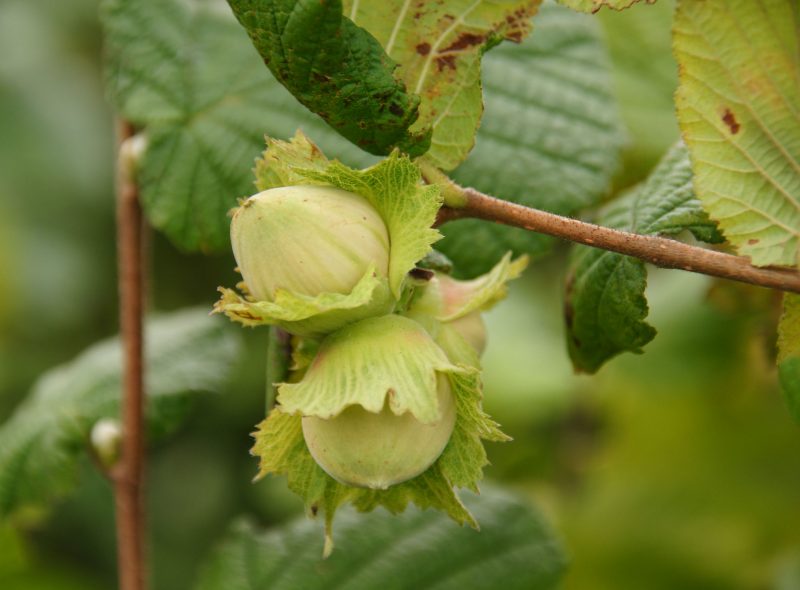
Large hazel, which is also called hazelnut, is grown in the Caucasus and Crimea.
Variegated hazel grows in the Amur Region. In the North Caucasus and Transcaucasia, you can find tree filbert, which is listed in the Red Book of the USSR.
Features of growing hazel
On the site, it is desirable to grow several varieties of hazel, as these are cross-pollinated plants. All hazel trees do not like acidic soils, they prefer soil with neutral acidity, planted on peat bogs begin to grow weak and grow poorly.
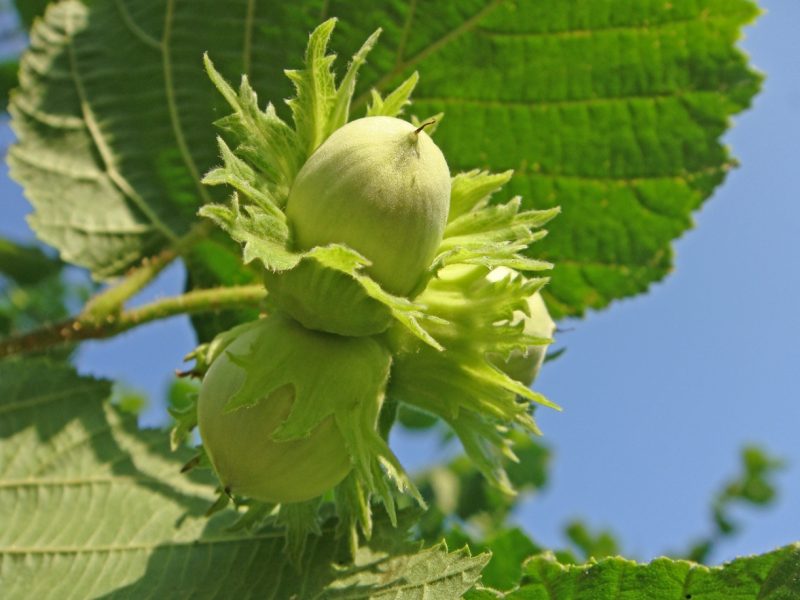
Watering is needed regularly, without this it is impossible to get a decent crop. If there is not enough moisture, the leaves will begin to fade. Hazel also needs special top dressing. The first complex fertilizers are applied in the spring, before the buds open.
The bush needs pruning annually, it grows a lot of lateral shoots, which need to be cut by secateurs. Without pruning, hazel will grow, drowning out other plants in the garden.
Most hazel trees are frost-resistant, only some heat-loving species freeze. In early spring, before the start of active sap flow, pruning is performed, removing all dry and frost-bitten branches.
Methods of propagation of hazel
A feature of hazel is that it cannot be grown by seed. The grown plants will not bear fruit for a long time. Hazel is best propagated by layering. Bushes from the layering begin to bear fruit the next year after planting, and retain all the varietal characteristics of the mother plant.
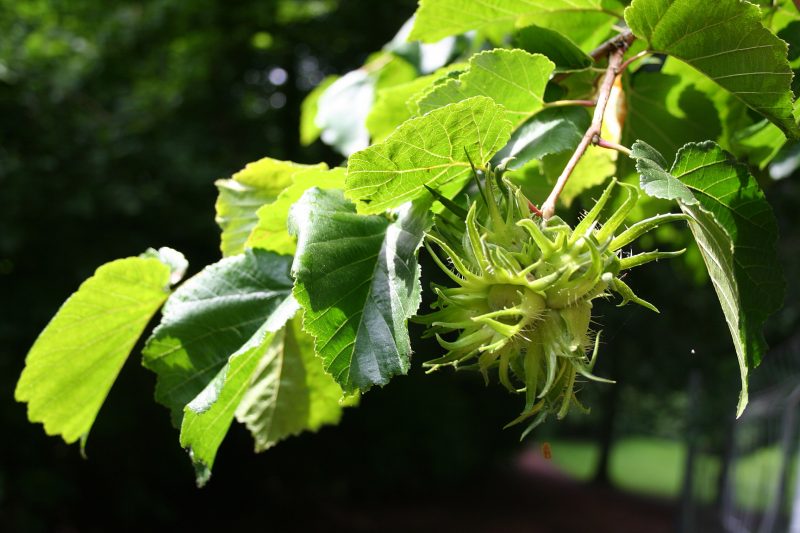
For proper propagation from the uterine plant, layering is rooted. The lower branches of hazel are sprinkled with ground with sawdust. In autumn, the shoots that have sprouted roots are separated, and planted in the soil, at a distance of 2-3 meters from each other.
You can propagate hazel cuttings. Cuttings take root best in spring. They are cut when cutting a bush, the lower cut is made oblique, and the upper one is straight, there should be 3 internodes on the handle. In order to better the process of root formation, succinic acid is used (the cuttings are soaked for 24 hours). Rooted in a small greenhouse, on the street, placing the stalk in the soil at an angle of 45 °. The greenhouse can be made independently from a box and a package. The roots will begin to grow about a month after planting, but in order for a complete root system to form, it takes several months.
Outdoor landing
You can plant a seedling in the open ground in autumn or spring, before buds open. Autumn hazel will begin to bear fruit faster, and spring planting will save it from freezing.

Hazel - a mycorrhizal plant that needs mushrooms for the full assimilation of nutrients by the roots. When planting, it is recommended to apply forest litter (lower layer) to a depth of 15 cm. Acidic soils need to be chalked before planting. When grown on acidic peat bogs, they make a large pit (80 cm in depth and the same in diameter), fill it with neutral soil, and only after that hazel is planted. The root neck can not be covered with earth.
In the first spring after planting, pruning is performed over a 5–6 bud for the appearance of lateral shoots and root shoots. The plant is grown in the form of a bush.
Hazel is not only useful, it can decorate the site with lush green foliage. You can plant it around the perimeter of the site, creating a live, green hedge, or use it as a knockout for other, higher plants. Hazel can be planted in a recreation area, it will create an interesting, openwork penumbra near a gazebo or bench. Diffused light or partial shade is well suited for this shrub.
Large-fruited hazel, from which they want to harvest a good crop, is planted in a well-lit place.
Plant Care Recommendations
Hazel grows in shrubs, so that the nuts are larger, you need to correctly form the crown. 10 to 14 shoots are left along the perimeter, and the middle of the bush is freed from the branches. Curved and sore branches are cut, as well as crowns growing inland.
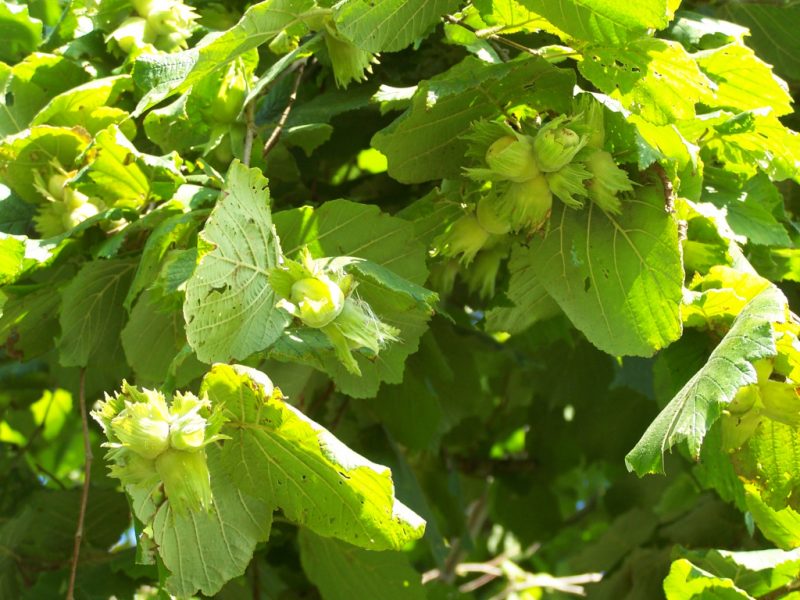
The soil around the plant is loosened, deepening the bayonet of the shovel no more than 10-15 cm, so as not to damage the roots.
In the second year after planting, hazel is fertilized with manure or compost. Mineral fertilizers are applied in the fall, when male flowers are laid (they resemble earrings), and in the spring when the female flowers.
The hazel bush needs to be rejuvenated once every 15–20 years, cutting it almost to the root. In general, this plant is unpretentious, and grows poorly only on swampy, saline, sandy soils and heavy loams.
Treatment of hazel from pests and diseases
Diseases do not pass hazel. The main problems are weevils and ticks. When a weevil is affected, larvae are planted in the fruits of the nut, and the crop crumbles ahead of time.
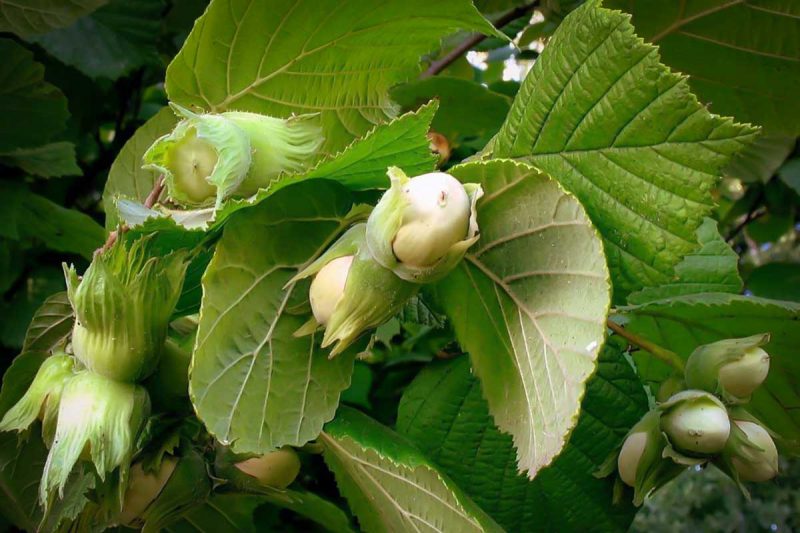
Fight them with insecticides and acaricides. It is impossible to spray plants during the ripening of the crop. This is done in the spring, before budding.
If a hazelnut barbel is wound up on the shoots, the branches are cut and burned, the plant is sprayed with Karbofos.
If done correctly, hazel will grow rapidly and give an abundant crop of delicious nuts.
Harvesting and storage
Harvest ripens in the fall, in September or October. It is believed that nuts ripen when they themselves separate from the pluses. The collected hazelnuts are scattered on the floor in a well-ventilated area with a layer of 3-4 cm, stirring occasionally, dried for about 10 days at an air temperature of 15 to 20 ° C. Then the nuts are collected in cloth or paper bags.
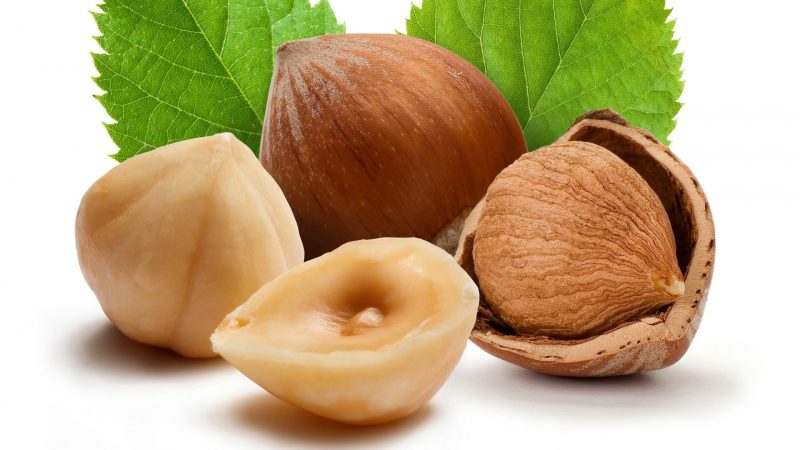
Nuts contain about 70% fat, up to 20% protein and 10% carbohydrates. They have a lot of potassium, phosphorus, iron, vitamins. They are more calorie than bread and pork.
Nuts are well stored for 3-4 years, without losing biological value and great taste. Use hazelnuts in the manufacture of confectionery products - sweets, cakes, halva, ice cream.
Hazel and hazelnuts, what's the difference
Hazelnuts are large-fruited varieties of common hazel, large hazel and Pontic hazel. Turkey grows 75% of the world's hazelnut crop. It is also cultivated in Georgia, Azerbaijan, Italy, Greece, and Russia.

The fruit of hazel varietal is a single-seeded nut more rounded and larger than that of wild hazel.
The bush of wild hazel is more powerful than that of hazelnuts, it can reach 5–7 m. Hazel tree, bear or Turkish grow up to 20 m in height - this is a real tree that prefer a warm climate, and freezes in mid-latitudes.
Hazel is one of the most unpretentious plants. Every year it brings a crop of delicious nuts, and can serve as a hedge on the site.












